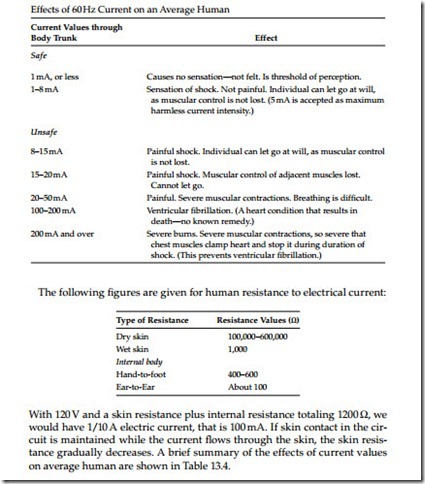Effects of Electrical Shock
Current is the killing factor in electrical shock. Voltage is important only in that it determines how much current will flow through a given body resistance. The current necessary to operate an l0 W light bulb has eight to ten times more current than the amount that would kill a lineman, that is, if it actually breaks through skin and body resistance and current of this amperage flows in the body. A voltage of 120 V is enough to cause a current to flow which is many times greater than that necessary to kill. Currents of 100 to 200 mA cause a fatal heart condition known as ventricular fibrillation for which there is no known remedy.
TABLE 13.4
Related posts:
Reliability-Cost Models for the Power Switching Devices of Wind Power Converters:Loss Model with Chi...
Multilevel Converters for Step-Up-Transformer-Less Direct Integration of Renewable Generation Units ...
Thermal Stress of 10-MW Wind Power Converter Under Normal Operation:Requirements and Conditions Unde...
Semiconductors:Thyristor Components
Mechanical fuel systems:Distributor pumps
Motors and Generators:DC Generators
The Current Situation and Perspectives on the Use of Wind Energy for Electricity Generation:France
Greener diesels:Dual-fuel engines
The Current Situation and Perspectives on the Use of Hydropower for Electricity Generation:Greece
HYDROPOWER:HYDROPOWER TURBINES
Taxonomy of Uncertainty Modeling Techniques in Renewable Energy System Studies:Simulation Results
Electrical fundamentals:Magnetism
Promising Topologies and Power Devices for Wind Power Converter:Promising Converter Topologies
The Current Situation and Perspectives on the Use of Geothermal Energy for Electricity Generation:Po...
MARINE POWER GENERATION TECHNOLOGIES:OCEAN THERMAL ENERGY CONVERSION
